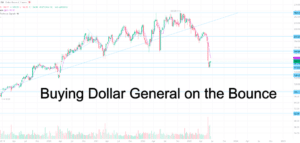Exploring Dollar General: A Unique Investment Opportunity

Welcome to another captivating episode of the How to Trade It Podcast with your host, Casey Stubbs.
In this exciting installment, we delve into a new investment opportunity that has caught Casey’s attention. But before we unveil the details, let’s take a moment to express our gratitude to our listeners and invite new subscribers to provide feedback via email at podcast@tradingstrategyguides.com.
In this episode, Casey discusses:
- a new investment opportunity
- the potential benefits of a recession for a discount store like Dollar General
- the release of his new book
You don’t want to miss it! ‘Wow, everything's organized. It's super clean and it's big!’, says trading expert, Casey Stubbs, about the newly opened Dollar General. Join us on this episode of How To Trade It to find out more! Click To Tweet
Subscribe to How To Trade It
Casey begins by sharing his recent encounter with Dollar General stores, providing a glimpse into his initial perceptions and how they transformed, after visiting a newly constructed store near his residence. What struck him the most was the store’s impeccable cleanliness, organization, and efficient automation. Dollar General’s strategic location strategy, catering to customers in remote areas, further piqued Casey’s interest.
Casey goes on to explain why Dollar General has become an intriguing investment opportunity for him. He sheds light on the company’s remarkable revenue growth, having amassed an astounding $10 billion increase over a span of just three years. While highlighting the consistency in earnings growth, Casey acknowledges a minor drop in 2022. Moreover, he touches upon the recent stock drop attributed to missed earnings and a projected mild recession. Despite this setback, Casey emphasizes the company’s attractive price-to-earnings ratio (P/E ratio) of 15, a notable advantage for a growing enterprise.
With the recent decline in Dollar General’s stock price, Casey believes it presents an exceptional buying opportunity. He reveals the company’s expansion into Montana, which contributes to its already extensive presence in 48 states. Casey also explores the potential benefits of a recession for a discount store like Dollar General, highlighting the demand it could generate. However, he encourages listeners to conduct their own thorough research before considering an investment in the company.
During this segment, Casey also tantalizes listeners with some exciting news. He mentions his upcoming book, “The Complete Trading System,” set to be released soon. For those eager to delve into the world of trading, this book promises to be an invaluable resource. Casey invites listeners to explore the book’s details and ensure they don’t miss its release. Additionally, he teases the upcoming launch of a unique indicator that traders can express interest in via email at podcast@tradingstrategyguides.com.
Casey expresses sincere gratitude to the podcast’s dedicated listeners for their continued support. He invites everyone to stay tuned for future episodes that promise to be as enlightening and informative as ever. For those hungry for updates, Casey encourages them to join the email list, ensuring they won’t miss out on the latest news regarding his new book release and the unveiling of a unique indicator.
Don’t miss out on the latest trading insights! Join our email list to stay updated on the release of Casey Stubbs’ book, “The Complete Trading System,” and express your interest in the upcoming unique indicator by emailing us at podcast@tradingstrategyguides.com.
Dollar General
Dollar General is a popular American discount retailer that operates a chain of variety stores across the United States. With a history dating back to 1939, the company has grown into one of the largest and most recognizable discount retailers in the country. Here’s an overview of Dollar General stores:
- Store Concept and Offering: Dollar General stores follow a simple and convenient retail concept. They offer a wide range of merchandise, including household essentials, cleaning supplies, groceries, health and beauty products, clothing, and seasonal items. The stores are designed to provide customers with a one-stop shopping experience at affordable prices.
- Store Locations: Dollar General has an extensive presence across the United States. Their stores are strategically located in rural, suburban, and urban areas, primarily targeting customers in smaller communities and underserved markets. Dollar General’s store network spans across 48 states, making it easily accessible to a wide customer base.
- Store Layout and Design: Dollar General stores are typically small to medium-sized, ranging from 7,300 to 15,000 square feet. The store layout emphasizes convenience and efficiency, with clearly organized aisles and product displays. The stores strive to maintain a clean and well-organized environment, ensuring an enjoyable shopping experience for customers.
- Affordability and Everyday Low Prices: Dollar General focuses on offering everyday low prices to attract value-conscious shoppers. By leveraging its purchasing power and efficient supply chain management, the company aims to provide customers with affordable options for their daily needs. This approach has helped Dollar General establish a reputation as a budget-friendly retailer.
- Customer Appeal: Dollar General stores cater to a diverse customer base, including individuals and families seeking affordable options, budget-conscious shoppers, and those living in remote or underserved areas. The company’s focus on providing convenience, low prices, and a broad product selection has contributed to its popularity among customers across different income levels.
- Community Engagement: Dollar General places importance on community involvement and engagement. Through its Dollar General Literacy Foundation, the company supports initiatives that promote literacy and education. It also partners with local organizations and schools to make a positive impact on the communities it serves.
- Company Growth and Performance: Dollar General has experienced significant growth over the years. The company continues to expand its store network, reaching more customers in both existing and new markets. Dollar General’s financial performance has been strong, with consistent revenue growth and a focus on generating shareholder value.
Dollar General’s commitment to providing affordable products, convenience, and a pleasant shopping experience has contributed to its success and made it a popular choice for consumers. The company’s ability to adapt to changing consumer preferences and effectively serve a broad customer base has solidified its position as a leading discount retailer in the United States.
Considering Investing Opportunities?
When evaluating whether a company is a good investment or has the potential for profitability, there are several key factors that investors should consider:
- Financial Performance: Review the company’s financial statements, including its revenue growth, profitability margins, and cash flow. Look for consistent and increasing revenue over time, healthy profit margins, and positive cash flow indicating the company’s ability to generate and manage funds effectively.
- Competitive Advantage: Assess the company’s competitive position within its industry. Look for unique strengths, such as proprietary technology, strong brand recognition, or a dominant market share that gives the company a sustainable advantage over its competitors.
- Management Team: Evaluate the company’s leadership and management team. Look for experienced executives with a track record of success, a clear strategic vision, and effective decision-making abilities. Strong leadership is often a crucial factor in a company’s long-term profitability.
- Industry and Market Conditions: Consider the industry in which the company operates and the overall market conditions. Evaluate factors such as market demand, industry trends, potential regulatory changes, and competitive landscape. A company operating in a growing industry with favorable market conditions is more likely to achieve profitability.
- Financial Stability: Assess the company’s financial stability and leverage. Look at the company’s debt levels, interest coverage ratio, and liquidity position. A financially stable company with manageable debt and sufficient liquidity is better positioned to weather economic downturns and capitalize on growth opportunities.
- Business Model and Growth Prospects: Evaluate the company’s business model and growth potential. Consider if the company has a scalable business model that can adapt to changing market dynamics and if there are opportunities for expansion into new markets or product lines. Look for innovation and a strong pipeline of products or services.
- Risk Factors: Identify and assess potential risks associated with the company, such as regulatory risks, competitive threats, technological disruptions, or macroeconomic factors. Understanding and managing risks is essential for long-term profitability.
It’s important to note that evaluating a company’s potential profitability requires thorough research and analysis. Investors should consider a combination of quantitative and qualitative factors to form a comprehensive assessment of a company’s prospects. Additionally, diversification across different companies and sectors can help mitigate risk and enhance overall investment returns.
Price-to-Earnings Ratio
The price-to-earnings ratio (P/E ratio) is a fundamental financial metric that provides investors with valuable insights into a company’s valuation. It is calculated by dividing the current market price per share of a company’s stock by its earnings per share (EPS). The P/E ratio is widely used as a benchmark for determining whether a stock is overvalued or undervalued.
A high P/E ratio may indicate that investors have high expectations for future growth, while a low P/E ratio may suggest that the stock is undervalued or facing challenges. However, it’s important to consider the P/E ratio in the context of the industry and the company’s growth prospects. A favorable P/E ratio, such as 15 for a growing company, can be an attractive factor for investors looking for potential investment opportunities.
People & Resources Mentioned:
- Find Casey’s book at Barnes & Noble and Amazon
- Sign up for Casey’s mailing list!
Connect With Casey Stubbs
- Website: https://tradingstrategyguides.com/
- Website: https://caseystubbs.com
- Website: https://globalproptrader.com/
- YouTube: https://www.youtube.com/TradingStrategyGuides
- YouTube: https://www.youtube.com/caseystubbs
- Twitter: https://www.twitter.com/caseystubbs
- Facebook: https://www.facebook.com/TradingStrategyGuides
- LinkedIn: https://www.linkedin.com/in/caseystubbs/
Subscribe to How To Trade It
Disclaimer: Trading carries a high level of risk, and may not be suitable for all investors. Before deciding to invest you should carefully consider your investment objectives, level of experience, and risk appetite. The possibility exists that you could sustain a loss of some or all of your initial investment. Therefore, you should not invest money that you cannot afford to lose. You should be aware of all the risks associated with foreign exchange trading, and seek advice from an independent financial advisor if you have any doubts.








